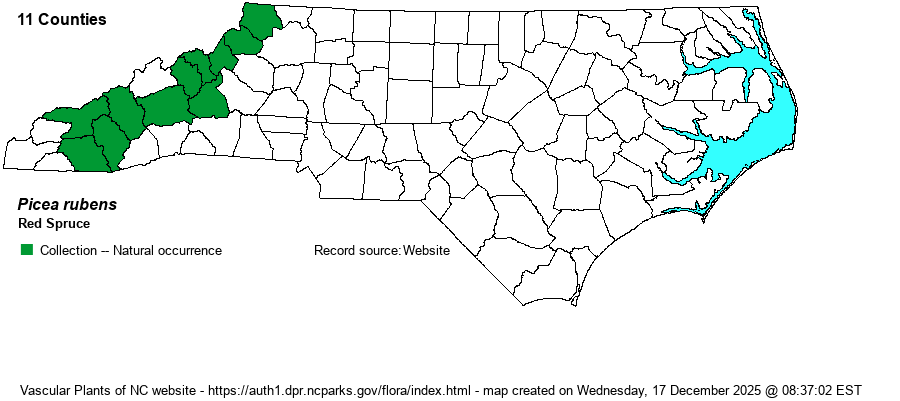| Author | Sargent | |
| Distribution | Nearly throughout the higher Mountains, mainly down to 5000 feet, but in some cooler valleys can be found down to around 4200 feet (as at Long Hope Valley and Alarka Laurel). Absent from a few counties at the southwestern tip of the state (Cherokee, Clay, and Graham). Photos from Madison County might be at suitable locations, but the website editors need more details to determine if the plants are from natural settings.
This is a Northern species ranging from N.S. and N.B. south mainly in the Appalachians to southwestern NC and eastern TN. | |
| Abundance | Though technically an uncommon tree in the Mountains, as with the Fraser Fir (Abies fraseri), it is common and easily found at higher elevations, usually mixed with the fir from elevations around 5000-5800 feet. Scarce below about 4500 feet elevation. Note that there are some peaks in the state over 5000 feet where neither spruce nor fir are found, such as most of those in the Amphibolite Mountains of Ashe and Watauga counties (i.e., north of Grandfather Mountain). Compared with Fraser Fir, this species has been relatively free of major die-offs in the state, though acid precipitation has been a problem to a small extent. | |
| Habitat | The species is found on high elevation slopes and mountain tops, often where rocky, and mostly above 5000 feet. Also, it is found in very cool microclimates in hanging valleys, where mainly in damp ground near bogs and swampy spots. It also occurs mixed with hardwoods on various rocky slopes below the typical spruce-fir zone. |
| Phenology | Cones shed pollen in May and June, and seeds in the cones ripen in October. | |
| Identification | This is a medium to occasionally tall evergreen tree, growing to 80 feet or taller, but with a shaggier appearance than the similar Fraser Fir. Though the needles grow densely on all sides of the twigs, as in the fir, the needles are four-sided (square in cross-section) and have sharp tips that are not rounded. If you grab a twig, you will feel some pain from the stiff and sharp needles; fir needles are more flexible, flat, and rounded, and grasping a twig does not cause discomfort. Hemlock twigs have needles more sparse along the stem, and the needles are flat and rounded. As with hemlock, the mature cones dangle down below the stems; fir cones grow upward from the stem. | |
| Taxonomic Comments | None
| |
| Other Common Name(s) | He Balsam, a very colloquial name that commoners use to distinguish it from the similar Fraser Fir (or Balsam Fir), called She Balsam by such folks. | |
| State Rank | S3 | |
| Global Rank | G5 | |
| State Status | | |
| US Status | | |
| USACE-agcp | FACU link |
| USACE-emp | FACU link |

